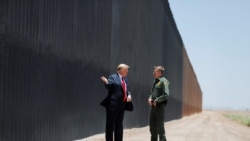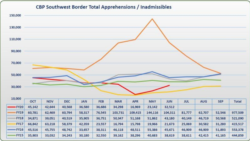On July 14, President Donald Trump changed the subject at a news conference on China sanctions to attack his opponent Joe Biden on immigration. Trump, who is trailing Biden in most polls, turned to one of the promises that drove his come-from-behind victory four years ago: building a southwest border wall.
Trump said his administration has built “up to 259 miles right now of great, powerful wall that’s really working because, if you look at the numbers, in addition to the fact that Mexico, for various reasons has 27,000 soldiers on our southern border to keep people out of our country […] And we have great, great numbers.”
Referring to Biden, the former vice president and presumptive Democratic party nominee in the Nov. 3 election, Trump said: "[It] was hard to get that built. And now it’s almost completed. It’ll be completed by a little after the end of the year, and they want to rip it down."
The statements are misleading.
‘Build that wall’
Trump’s main focus during the 2016 presidential election campaign was illegal immigration. The chant “build that wall” was heard at all of his rallies, during which he promised to stop undocumented immigrants who were coming into the country and, in his words, “stealing our jobs."
As a candidate, Trump promised to build a 2,000-mile wall along the southern border with Mexico. The number later shrunk as Trump clarified that some of the wall would consist of natural barriers such as mountains and rivers.
After Trump took office, the proposed length of the wall changed again – to around 450 miles that would be delivered by the end of 2020.
With less than six months left before year’s end, the actual border wall construction falls well short of that promise. Trump said in his Rose Garden remarks this week that 259 miles were finished. In a tweet two days earlier, he used the figure of 240 miles.
According to the U.S. Customs and Border Patrol’s (CBP) website, as of July 13, 235 miles had been built. However, the agency said the estimate is approximate, as "construction activities are ongoing.”
Replacement vs. new
When Trump took office, 655 miles of the nearly 2,000-mile border between the U.S. and Mexico already had barriers. Most were constructed during the presidencies of Barack Obama and George W. Bush, who in 2006 signed the Secure Fence Act, authorizing “hundreds of miles of additional fencing.”
Most of the border-wall construction under the Trump administration has replaced already existing barriers. According to CNN's fact-checker, Daniel Dale, official figures as of June 19 show that out of the 216 miles built since January 2017, only three miles were new. The rest, according to Dale, replaced old barriers or were secondary barriers.
The Los Angeles Times reported on June 30 that since mid-January of this year, 95 miles of new and replacement walls were built – two miles of new wall in California and Texas, and 93 miles of replacement walls.
In places where border wall must be built on private property, only a small portion of that property has been acquired - 10 of the 213 miles in the Laredo and Rio Grande Valley, according to CBP data from May 19 obtained by The New York Times.
The Times said seven of the 10 miles were acquired since December, around the same time the Trump administration ratcheted up lawsuits against landowners in south Texas.
During the 2016 campaign, Trump said that Mexico would pay for the border wall. That hasn’t happened.
Congress approved $4.5 billion in border wall funding, but the Trump administration has pushed for more. An attempt by the administration to transfer $2.5 billion from the Pentagon to wall construction was blocked by a federal appeals court. On June 26, the court ruled that administration didn’t have the authority for the transfer without congressional approval.
This year, the administration notified Congress again that it was diverting another $3.8 billion from the Pentagon, a move criticized by Democrats and a few Republicans.
According to the CBP, the “border wall system,” which includes primary and secondary walls, was projected to cost over $11 billion and span 576 miles, or approximately $19 million per mile.
Border apprehensions
Trump’s assertion that migrant arrests and expulsions along the border are down is generally in sync with CBP figures.
However, it’s not clear that the border wall has much to do with it.
In May, the Pew Research Center reported that overall migrant movement is down because of the coronavirus pandemic. Mexico restricted border crossings to essential travel, and Central American countries have effectively closed their borders.
This year, the profile of migrants being picked up has changed, Pew reported. Most of those apprehended so far in 2020 were Mexican, while in 2019 most were from Guatemala, Honduras and El Salvador. Also, most of those apprehended this year have been unaccompanied adults, rather than families or minors, as in the prior year.
The latest CBP statistics show that southwest border apprehensions hit a low of about 17,000 in April, but ticked back up to nearly 33,000 in June. That is well below the period from March to June 2019, when the totals exceeded 100,000 a month.








